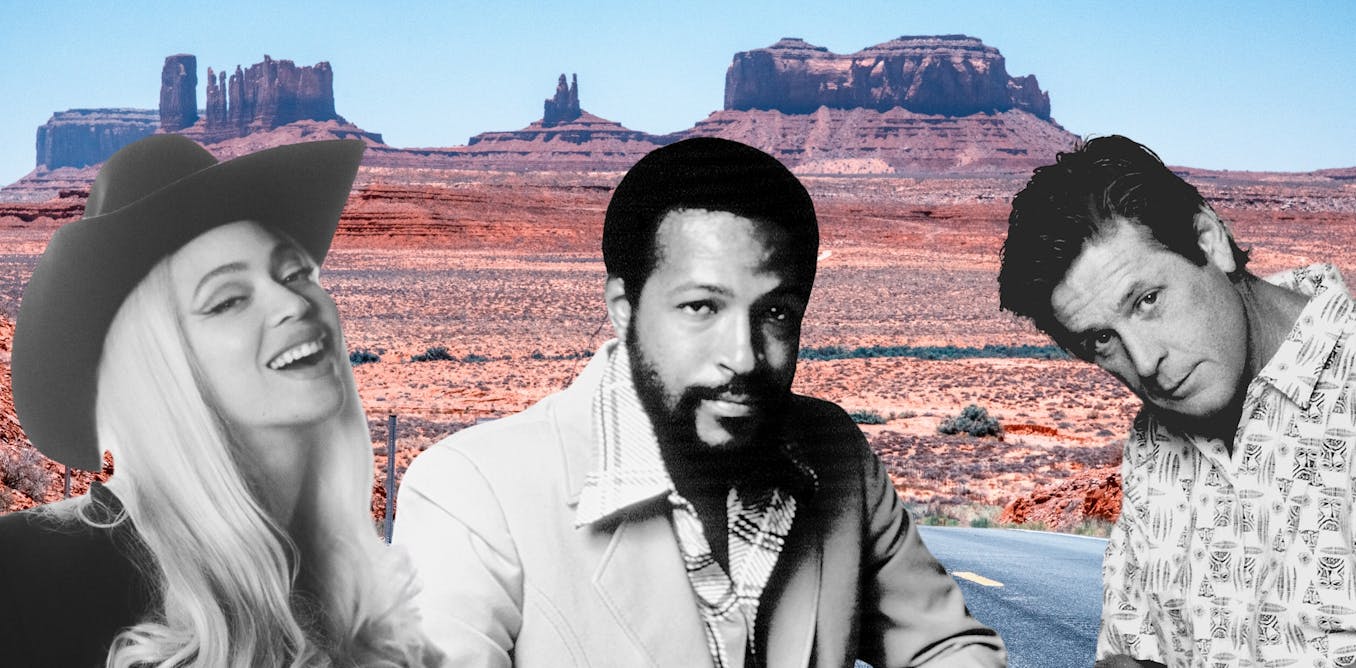Five classic concept albums that will take you on a sonic road-trip across America

مجلة المذنب نت متابعات عالمية:
The concept album is often viewed as an art form that is primarily focused on lyrical storytelling. But in these five key records, musical ambition, performance and production combine to take the listener on a road-trip through America.
1. Gunfighter Ballads and Trail Songs by Marty Robbins (1959)
Gunfighter Ballads and Trail Songs, by Marty Robbins, has rightly been lauded as one of the most important artworks of the 20th century – indeed it was preserved in the Library of Congress in 2017.
The thematic album transports the listener into a mythical west. Each song tells its own story, but there is a distinct unity of characterisation. The tearful convict awaiting death in They’re Hanging Me Tonight might well be an alter ego of the desert rider, hallucinating and desperate in Cool Water. Or even the ebullient narrator celebrating his own American dream in A Hundred and Sixty Acres.
The album’s arrangements are mostly simple and stripped back, allowing Robbins’ extraordinary vocal performances and expressive backing vocal arrangements to fly. This reaches a stylistic peak in his greatest song, the white-knuckle ride of El Paso, wherein our protagonist willingly throws himself into a living hell.
2. Smile by Brian Wilson (2004)
The Beach Boys released 15 studio albums in the 1960s. Their voluminous output represented one of the most supercharged evolutions in contemporary music – fired by the imagination, energy and ambition of Brian Wilson.
In 1965, in partnership with lyricist Mike Love, Wilson was extolling the virtues of California girls. Just a few months later, he was creating the mature, introspective humanity of Pet Sounds with collaborator Tony Asher. From there Wilson engaged lyricist Van Dyke Parks to help him realise an “American gothic trip”. Smile describes a journey across the country on the “ribbon of concrete”, or along the railroad with the early settlers.
One key track on Smile, Heroes and Villains, took its narrative cue directly from Marty Robbins’ El Paso. But others – Cabin Essence and Surf’s Up – painted a new old west and still feel revolutionary today. However, the album became most famous for being left unfinished for 34 years, with snippets appearing piecemeal before its completion as a new recording by Brian Wilson in 2004.
Van Dyke Park’s lyrics remain intriguing and unique. But I’d argue the real conceptual unity of Smile comes from its musical design. This is an album about American music as much as it is about America. It’s a kaleidoscope of Gershwin, Ives, Bernstein and goofy doo-wop, scaffolded by unexpected and rich textural juxtapositions (double bass, banjo and backing vocals going “boing boing” anyone?). And, of course, there’s the peerless vocal performances of The Beach Boys.
3. The Delta Sweete by Bobbie Gentry (1968)
Bobbie Gentry’s The Delta Sweete is another concept album that looks at both America (in this case the Mississippi Delta) and American music.
Gentry first found fame with Ode to Billie Joe, a narrative ballad that became a major hit single. In The Delta Sweete, Gentry blended her own distinctive vignettes of southern life with skilfully curated covers of classics, like Mose Allison’s Parchman Farm.
In Reunion, Gentry invites listeners into the front parlour of an alternately loving and warring southern family. She illustrates the scene by interweaving dialogue, vocal chants and rhythmic solo cello. Elsewhere we meet the swaggering, comedic Okolona River Bottom Band and experience a southern gothic nightmare in Refractions.
The sense of journey is enhanced by a series of orchestral pieces that link each of the 12 tracks. So when we finally alight on the solitude of the closing track, Courtyard, there is a feeling of coming home.
The ambition of The Delta Sweete was not met with commercial success, but Gentry never quite gave up the conceptual flame. Her follow up – Local Gentry, in 1968 – shared some of the same approach to musical portraiture. And in her final studio album, Patchwork (1971), she returned to a series of vignettes with orchestral links. All make for essential listening.
4. What’s Going On by Marvin Gaye (1971)
From a journey across America, to a journey across the Mississippi Delta, we turn now to the streets of 1971 inner-city America, via Marvin Gaye’s masterly record, What’s Going On.
This album represented a clear shift in Gaye’s artistic voice towards commentary, question and critique, against the will of Motown Records boss Berry Gordy resulting in a standoff during which Gaye threatened never to record for the label again. What’s Going On is perhaps most famous for its engagement with the social and political issues of the day, but the ambition of the music, performance and sound stand up thrillingly, 55 years after its release.
Motown Records house arranger David Van De Pitte set congas and guiros against sweeping orchestral arrangements, glockenspiel, choirs and jazz influences. The juxtaposition of tempo and feel created by transitions between the tracks hold you there as listener, walking around Gaye’s landscape, and seeing it through his eyes.
The key sound of What’s Going On though – and the element that most solidifies its status as a conceptual album – is the approach taken with the vocals. Different takes of the same song overlap, and different ad libs collide and diverge as choral passages peek out from the background. These are the voices talking to Gaye during his walk through the inner city of What’s Going On.
5. Cowboy Carter by Beyoncé (2024)
Cowboy Carter’s conceptual birth sprang from the artist’s performance at the 2016 Country Association Awards, where prejudiced questions were raised (in the room and online) about Beyonce’s legitimacy and place in the context of a country music performance. Her ultimate response was this detailed exploration, celebration and critique that gets under the skin of American music itself. Beyoncé creates a searing and detailed a commentary on, and road-map to, American music.
Read more:
The genius of Cowboy Carter is Beyoncé’s accent – a musicologist explains
Big questions around the origin and evolution of genre are asked via the medium of a Jolene cover, use of the banjo, impressionistic music arrangements and flights of performative imagination.
There are spoken inserts (from Linda Martell, Willie Nelson and Dolly Parton) and striking musical juxtapositions. Like other albums on this list, Cowboy Carter’s conceptual veracity springs as much from this kaleidoscopic approach to sound as from the central narrative at its heart.
In this collage we hear new songs, interpretations of classic songs and quotes from American classics, including one from The Beach Boys’ Smile – Good Vibrations.
Looking for something good? Cut through the noise with a carefully curated selection of the latest releases, live events and exhibitions, straight to your inbox every fortnight, on Fridays. Sign up here.
نشكركم على قراءة المنشور عبر مجلة المذنب نت, المتخصصة في التداول والعملات الرقمية والمشفرة













